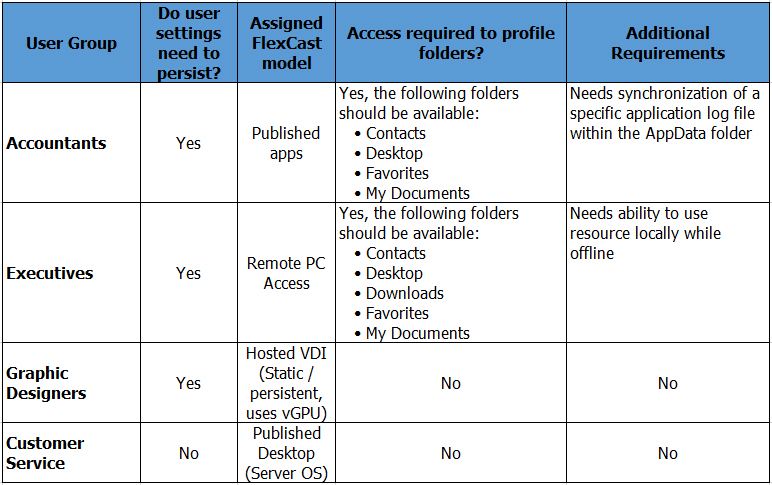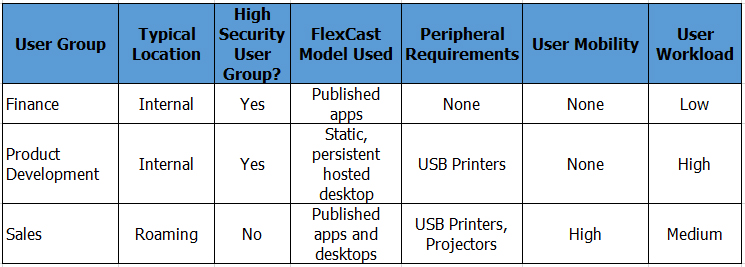Citrix® 1Y0-402 Exam Practice Questions (P. 5)
- Full Access (128 questions)
- Six months of Premium Access
- Access to one million comments
- Seamless ChatGPT Integration
- Ability to download PDF files
- Anki Flashcard files for revision
- No Captcha & No AdSense
- Advanced Exam Configuration
Question #21
Scenario: After a recent security assessment, a Citrix Architect recommends blocking unnecessary peripheral types by disabling the associated HDX channels.
Currently, the environment is intended to support the peripheral types listed in the Exhibit.
Click the Exhibit button to view the supported peripheral types.

Which four HDX virtual channels should the architect disable, based on the peripherals required in the environment? (Choose four.)
Currently, the environment is intended to support the peripheral types listed in the Exhibit.
Click the Exhibit button to view the supported peripheral types.

Which four HDX virtual channels should the architect disable, based on the peripherals required in the environment? (Choose four.)
- ASmartCardMost Voted
- BTWI
- CPrintMost Voted
- DClientAudioMost Voted
- EGenericUSBMost Voted
- FTwainRdr
- GMultimedia
Correct Answer:
ACDE
ACDE
send
light_mode
delete
Question #22
Scenario: A Citrix Architect is designing an environment for a large company. The company has identified the following user groups and requirements.
✑ Product Managers - Typically, they work from inside the company network but are able to work from home. They need to use a variety of standard productivity and web-based SaaS applications.
✑ Field Sales Engineers - They frequently work with mobile devices and tend to access the environment externally. They need access to sales tools and the front-end of the customer database.
✑ Web Developers - Internal and remote workers who use specialized hardware with a graphics card to handle resource-intensive applications.
Which FlexCast model should the architect assign to Product Managers?
✑ Product Managers - Typically, they work from inside the company network but are able to work from home. They need to use a variety of standard productivity and web-based SaaS applications.
✑ Field Sales Engineers - They frequently work with mobile devices and tend to access the environment externally. They need access to sales tools and the front-end of the customer database.
✑ Web Developers - Internal and remote workers who use specialized hardware with a graphics card to handle resource-intensive applications.
Which FlexCast model should the architect assign to Product Managers?
- AHosted VDI
- BRemote PC
- CVM Hosted Applications
- DPublished AppsMost Voted
- EPublished Desktops
Correct Answer:
A
A
send
light_mode
delete
Question #23
Scenario: A Citrix Architect needs to design a new XenApp and XenDesktop environment.
The architect has identified the Resource Layer requirements shown in the Exhibit.
Click the Exhibit button to view the requirements.

Additionally, management at the organization has identified the following general Resource Layer requirements:
✑ The profile solution should minimize logon and logoff times as much as possible.
✑ The time required to configure and maintain the solution should be minimized.
✑ User groups do NOT need to use the same profile type.
Which profile type should the architect use for the Customer Service group?
The architect has identified the Resource Layer requirements shown in the Exhibit.
Click the Exhibit button to view the requirements.

Additionally, management at the organization has identified the following general Resource Layer requirements:
✑ The profile solution should minimize logon and logoff times as much as possible.
✑ The time required to configure and maintain the solution should be minimized.
✑ User groups do NOT need to use the same profile type.
Which profile type should the architect use for the Customer Service group?
- AMicrosoft roaming
- BMandatoryMost Voted
- CLocal
- DCitrix Profile Management
Correct Answer:
C
C
send
light_mode
delete
Question #24
Scenario: A Citrix Architect needs to manage the disaster recovery process for a XenApp and XenDesktop environment. The environment currently consists of an active datacenter which is typically accessed by users and a disaster recovery (DR) datacenter which would be used in the event that a disaster impacts the primary datacenter. The organization has made it a priority to minimize the loss of data when failing over between datacenters and has begun planning for an event in which the environment must fail over from the primary datacenter to the DR datacenter.
What is the appropriate sequence of steps that the architect should follow after getting management approval to complete the process in case of such an event?
What is the appropriate sequence of steps that the architect should follow after getting management approval to complete the process in case of such an event?
- ABlock access to primary datacenter, complete replication, terminate/drain existing sessions, reverse direction of replication, enable access in DR datacenter
- BBlock access to primary datacenter, terminate/drain existing sessions, complete replication, reverse direction of replication, enable access in DR datacenter
- CTerminate/drain existing sessions, complete replication, block access to primary datacenter, enable access in DR datacenter, reverse direction of replication
- DComplete replication, terminate/drain existing sessions, block access to primary datacenter, reverse direction of replication, enable access in DR datacenter
- EComplete replication; block access to primary datacenter, terminate/drain existing sessions, enable access in DR datacenter, reverse direction of replication
- FTerminate/drain existing sessions; block access to primary datacenter, complete replication, reverse direction of replication, enable access in DR datacenter
Correct Answer:
D
D
send
light_mode
delete
Question #25
Scenario: A Citrix Architect is designing a new XenApp and XenDesktop environment and needs to determine which endpoints to include. Based on discussions with various departments, the user requirements listed in the Exhibit were collected.
Click the Exhibit button to view the requirements.

In addition to the user requirements, the architect has identified the following organizational requirements:
✑ Minimize total cost of ownership (TCO)
✑ Minimize maintenance costs
Which endpoint type should the architect use for the Product Development group, based on the requirements?
Click the Exhibit button to view the requirements.

In addition to the user requirements, the architect has identified the following organizational requirements:
✑ Minimize total cost of ownership (TCO)
✑ Minimize maintenance costs
Which endpoint type should the architect use for the Product Development group, based on the requirements?
- ABYOD laptop/notebook
- BCorporate-owned high-performance workstation
- CCorporate-owned standard desktop
- DCorporate-owned laptop/notebook
- ECorporate-owned thin client
Correct Answer:
E
E
send
light_mode
delete
All Pages
